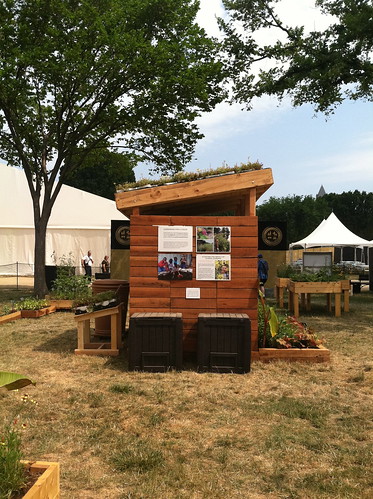
Wednesday was opening day of the 2012 Smithsonian Folklife Festival on the National Mall. The Festival features three great themes. One of the themes entitled “Campus and Community” is a program that commemorates the 150th Anniversary of the founding of Land grant universities and the USDA. The People’s Garden Initiative is thrilled to have an exhibition in the Reinventing Agriculture area of Campus and Community. Please stop by to see it and talk gardening with USDA’s Executive Master Gardeners! Like us, universities from across the country are demonstrating how they engage communities through gardening. The Festival runs June 27 to July 1 and July 4-8 from 11 a.m. to 5:30 p.m.
Our living exhibit showcases different types of gardens that qualify as People’s Gardens and demonstrates several relatively simple, inexpensive, and environmentally friendly practices that both beginner and expert gardeners can implement to make our communities healthier places to live, work and play.
The types of gardens demonstrated include all access, edible, pollinator, and container. These gardens surround a shed with sustainable features like designing with reclaimed materials, making and using compost, setting up a rain barrel, and installing a green roof. 20-minute demonstrations on these sustainable practices are offered daily.
Visitors have been quite curious about the sheds design, who built it and what it is made from. I talked with Bob Snieckus, National Landscape Architect for USDA’s Natural Resources Conservation Service and Michael Roggerson, Lead Carpenter at the University of the District of Columbia (UDC) for answers.

How did you come up with the idea of this shed?
Bob Snieckus: Matt Arnn, Chief Landscape Architect for the U.S. Forest Service, and myself came up with this idea to showcase sustainable shed design. We wanted to show people at the Folklife Festival how organic material can be used. This shed features different species of urban timber, open and airy construction, and a green roof.
How did UDC contribute in the process of planning and building the shed?
Michael Roggerson: The shed was built in partnership between USDA and UDC, a Land grant university here in Washington, DC. Clarence W. Pearson, Jr. in the Department of Architecture and Urban Design at UDC worked with Bob Snieckus on the design plans for the shed. We built the shed at our university in about a week from morning until evening, while USDA oversaw the project. We had about ten architecture students total building it, and about five or six per day.
How did the shed get moved from UDC to the National Mall?
Bob Snieckus: The plans were originally designed for the shed to be built and remain in the People’s Garden at USDA Headquarters. I learned to modify the design so that it could be assembled and then disassembled and transported from UDC to the Festival site.
What are the different elements of the shed?
Bob Snieckus: The door is white oak that came from fallen and removed urban trees from the District of Columbia. We used red oak and poplar for the siding. The floor rim joists are naturally insect resistant black locust. The shed has a green roof and rain barrel attachment. The soil and plants that we put on the roof add an extra 1500 pounds, so we had to design a structure to hold more weight than a normal shed. We used posts and ceiling joists made from fir trees to hold up the plywood roof.
Where can you buy this type of reclaimed wood?
Bob Snieckus: There are a few lumber mills around the area in D.C. and Maryland. The mills stockpile the trees from various sources and then cut the wood to the sizes that you request. Most of the wood comes from trees that were old or diseased and were lining streets and railroad tracks. The Urban Forestry Administration is a good place in the District of Columbia government that has a lot of info on what types of wood to use. They can also help you with your design and source of wood.
How durable and long-lasting is this shed?
Bob Snieckus: Very. It will last for years and years. That’s because in the base we used black locust which naturally prevents termite decay. We also sealed the wood with a liquid water proofing material so that weather won’t speed up decay.
What do you plan to do with the shed once the festival is over?
Bob Snieckus: We hope to move it to The People’s Garden on the corner. We want to add shelving and hooks so that gardening tools can be stored in it.
